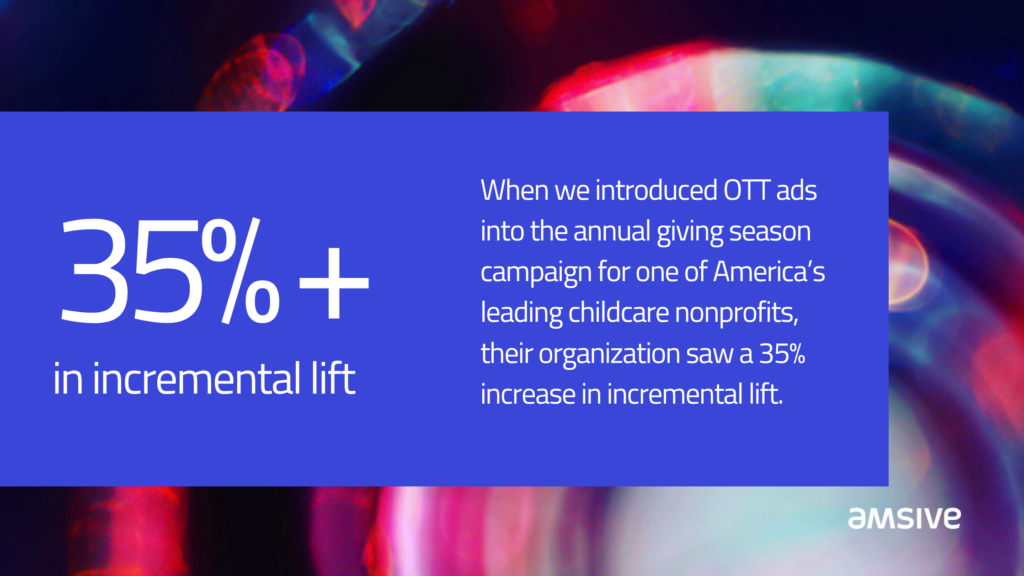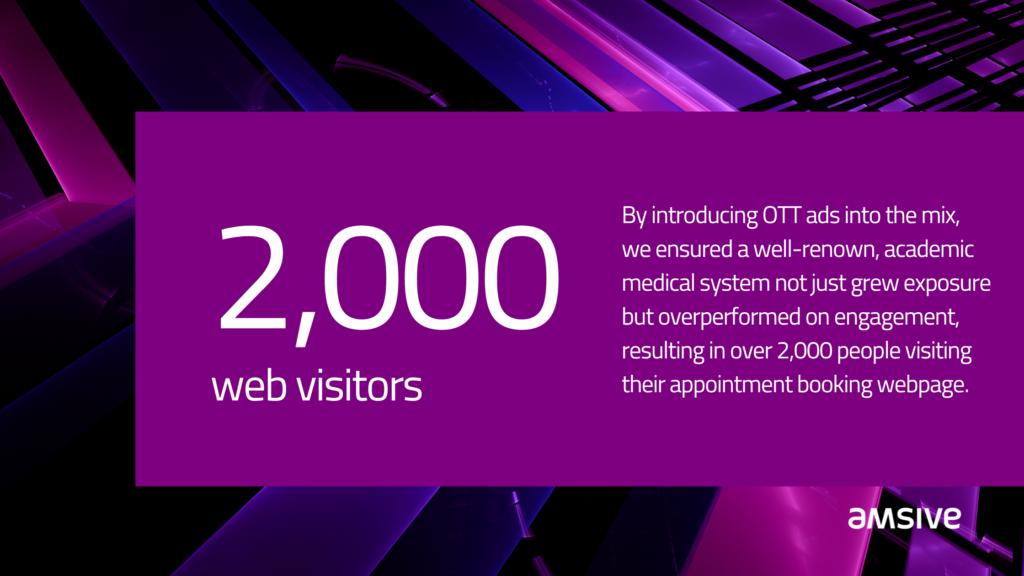Connected TV (CTV) households are set to double in 2024. In merely months, there will be 115 million connected TV (CTV) households compared to 56.6 million traditional pay TV households. CTV and over-the-top (OTT) advertising is a given for marketers focused on performance and hyper-personalized brand experiences as part of a comprehensive multichannel strategy.
But streamlining and optimizing this channel is easier said than done. According to MediaPost, most CTV ads miss the frequency ‘sweet spot’. That’s just one challenge marketers face with CTV/OTT advertising. As the media landscape continues to fragment, deftly navigating changes ensures you’re ahead of your competition.
With CTV advertising to exceed $30 billion next year, brands will jostle for attention with this fast-growing ad format. End-to-end CTV solutions seamlessly integrated within audience-led multichannel campaigns ensure the ideal ads reach the right people at critical moments.
Learn how to stay ahead of the curve for 2024.
Jump To:
What’s considered CTV vs. OTT?
Linear TV is the traditional method of television broadcasting, where viewers watch scheduled programs on specific channels at set times. This format includes cable, satellite, and terrestrial television, and it’s characterized by a fixed programming schedule decided by the broadcasters.
CTV is specifically about the devices enabling TV streaming through the internet. It’s the hardware aspect — the smart TVs and devices connected to televisions. Think smart TVs, streaming sticks, gaming consoles, blu-ray players and set-top boxes.
OTT refers to the method of delivering content directly over the internet, bypassing traditional broadcast models. It encompasses a broader range of devices, including all CTVs, smartphones, tablets, and computers. That’s going to be subscription video-on-demand, ad-supported video-on-demand, live TV streaming services, sports streaming services, and other niche streaming services
The streaming landscape includes a complex variety of players that many modern marketers might shy away from, focused instead on just getting ads onto a screen. However, performance-driven agency partnerships can help you navigate key relationships, including:
- Data Providers
- Demand-Side Platforms (DSPs)
- Supply-Side Platform (SSPs)
- Ad Servers
- Analytics
- Publisher/Aggregator
With an expanding and fragmenting TV advertising landscape and a quickened pace of changes in consumer behavior, audience-led, performance-driven strategies have the opportunity to drive ROI. Consistently optimizing your CTV strategy ensures you stay ahead of the curve.
How to optimize your CTV advertising
In the evolving landscape of Connected TV (CTV) advertising, certain strategies have emerged as particularly effective in maximizing campaign impact. By understanding and implementing these tactics, advertisers can significantly enhance the effectiveness of their CTV ads:
Optimal Frequency Range: Aim for a frequency of 6-10 impressions per viewer. This range has been identified as the ‘sweet spot,’ where ads are most effective. Frequencies lower or higher than this range tend to be less impactful, either due to underexposure or viewer fatigue.
Strategic Scheduling: Schedule a strategic gap of hours between each CTV impression. This approach helps maintain viewer engagement without causing ad fatigue. It’s a delicate balance between keeping the brand top-of-mind and avoiding overexposure.
First Ad Slot Advantage: The first ad slot in an ad pod typically garners the most attention and effectiveness. While some platforms like The Trade Desk (TTD) may not offer the capability to target specific ad slots, other vendors do. Leveraging this knowledge can give advertisers a significant edge.
Diverse Creative Content: Develop multiple ad creatives. Brands that rotate and change content from impression to impression tend to gain more awareness compared to those that repetitively run the same ad. Fresh and varied content keeps the audience engaged and curious.
Allocating Budget for Creative Development: For substantial CTV advertising budgets, consider allocating a portion of their budget to creative development. Investing in creating a variety of high-quality ads can significantly enhance the campaign’s effectiveness.
Content and Theme Alignment: Ads that match the content or theme of the program they appear in are typically more effective, creating a more cohesive and engaging viewing experience.
Crafting the Ideal Ad: Viewer feedback highlights preferences for ads that are humorous, succinct, feature appealing or catchy music, clearly identify the brand, and narrate a story. Ads meeting these criteria tend to be more favorably received, making them more likely to resonate with the audience and foster brand recall.
Implementing these strategies can lead to more effective CTV campaigns, offering brands a better return on investment and a stronger connection with their target audience. For agencies like Amsive, which specialize in data-led, innovative marketing solutions, these insights are invaluable for guiding clients in their CTV advertising endeavors.
Offering rising reach, precision targeting, and efficient measurement, OTT ads have leapt past what the traditional TV industry could offer advertisers. Today, the majority of Gen Z, Millenial, and even Gen X audiences in the U.S. are digital video users, frequently viewing OTT ads.
Measuring the effectiveness of CTV advertising
While traditional TV advertising attribution has been based on broader demographics and information, OTT’s digital capabilities can drill further into ad performance and viewer behavior. This ultimately can result in matches down to a household level — if you have access to the right partnerships, databases, and more. Aiding cross-channel visibility, OTT helps marketers deal with increased pressure to maximize spend in the multi-touch landscape. Analytics can report on ROAS/CPA, while optimizing towards the best possible performance.
Beyond its well-known benefits, OTT ads offer cross-platform capabilities with unprecedented levels of insight into your linear TV efforts, measuring how effective your OTT is at reaching new, incremental people that weren’t reached with linear TV buys.
One of the more fascinating and revealing measurements of CTV advertising effectiveness is through footfall attribution, which relates campaign impressions or conversions to store visits. Footfall attribution helps businesses see how their digital ads contribute to their brick-and-mortar stores’ foot traffic. With the ability to provide data related to how much time customers spend in a store, how often and what times they visit, and which stores are visited the most, footfall attribution is a valuable measurement tool for brands in determining how their CTV advertising is impacting in-store business.
Television has always been used as a top-of-the-funnel marketing component, but CTV has transformed the medium into a tool that now delivers bottom-of-the-funnel KPIs and insights such as foot traffic, site attribution and conversion, and location attribution. And through these valuable metrics, advertisers can more effectively allocate ad spend to the right channels.
CTV advertising trends for 2024
Looking to the future of CTV advertising is critical for businesses to stay ahead of the curve. Here are a few CTV advertising trends to look for in the coming year.
Even More Connections
The number of people cutting the proverbial cord and switching to streaming services has shown extensive, consistent growth for the past decade. That isn’t changing anytime soon. Even those who are reluctant to cut the cord completely are increasingly turning to streaming services and CTV devices, and that trend is expected to continue in 2024.
Targeting That’s Even More Precise
CTV advertising is already quite specific in who it can target with its campaigns. The data and technology are only becoming more advanced, so it won’t be a surprise when targeting becomes more advanced as well.
More Cross-Channel Campaign Integration
CTV ad growth is projected to hit an all-time high by the end of 2024. And one of the many advantages of CTV advertising is its ability to seamlessly work with existing channels, such as mobile video and social media. Because of that compatibility, look for advertisers to take full advantage in 2024 and create effective cross-channel advertising strategies accordingly.
Increased Interactivity
While not the newest concept, shoppable ads are expected to take off in 2024 thanks to the increase in CTV ad spend as well as the personalized ad experience CTV advertising offers. The most common of these experiences has been the usage of QR codes in ads, which guide viewers directly to a product, promotional, or purchase page. A few clicks of the remote later, businesses have a sale. Product showcases are also an effective interactive customer experience, where product or service information is provided in the ad as well as a simple way to complete the purchase. Even easier is the use of voice-activated remotes or devices (Alexa, Google Nest) to instantly add products to a shopping list or make a purchase on the spot via voice commands.
With new tools and innovations in constant development, the future is bright for CTV advertising. Especially as it increasingly Ai continues to integrate into its processes.
Enhancing CTV advertising with GenAI
The integration of Artificial Intelligence (AI) in Connected TV (CTV) advertising is revolutionizing the industry, with GenAI emerging as a game-changer. This advanced AI technology is particularly transformative in mastering the challenges of big data analysis and real-time decision-making in the CTV space.
In the realm of CTV advertising, the amount of data available is colossal. We’re talking about billions of terabytes encompassing behavioral trends, household data, viewing patterns, and more. Traditional data processing methods fall short in this scenario, but GenAI excels. It can analyze these vast data sets in milliseconds, offering insights that were previously unattainable. This capacity to process massive amounts of data rapidly is not just about efficiency; it’s about unlocking new possibilities in audience understanding and targeting precision.
The competitive nature of CTV advertising, underscored by the scarcity of inventory and the billions of devices streaming content, necessitates ultra-timely decisions. Here, GenAI plays a critical role. In a landscape where fractions of a second can mean the difference between capturing an opportunity or losing it to a competitor, AI’s real-time processing capability is invaluable. This speed and efficiency are especially crucial in programmatic advertising, where seizing the moment is key to success.
Moreover, GenAI transforms CTV ads from generic interruptions to efficient, relevant, and waste-free touchpoints. By leveraging AI to gain a deeper understanding of viewers’ behaviors, habits, and interests, advertisers can ensure that their CTV ads reach the most appropriate audience. This precision not only enhances the viewer experience but also significantly improves advertising effectiveness.
Furthermore, the dynamic nature of audience preferences in the CTV space can be challenging to keep up with. GenAI, with its continuous learning capabilities, adapts to these changes, enabling advertisers to adjust their strategies in real-time to align with evolving viewer trends. This adaptability ensures that CTV campaigns remain relevant and effective over time.
In conclusion, GenAI’s role in CTV advertising is pivotal. It’s not just about processing data; it’s about transforming it into actionable insights that lead to more impactful, relevant, and successful advertising campaigns. For businesses and agencies like Amsive, leveraging GenAI in their CTV advertising strategies is essential for achieving greater efficiency, precision, and effectiveness in the rapidly evolving digital advertising landscape. This approach not only maximizes ROI but also minimizes waste, making the most of every advertising dollar spent.
In the field with OTT ads
TV ads are viewed, especially by older generations, as a type of ad only reputable brands use, creating high levels of brand trust beyond just awareness. This translates into the new TV landscape. But there’s so much more that adding OTT ads can do.
Our teams have achieved increased incremental conversions directly attributed to people after they see a CTV ad, tracked via our call tracking. This means someone sees a CTV ad and calls the number on the screen, a number unique to only one CTV spot, and that can be specifically attributed within our tracking system. We’ve also seen increased conversions when CTV ad audiences are retargeted with display ads post-TV spot. Furthermore, OTT ads open up eyes into “view-through conversions.” That’s when someone sees a CTV ad on their connected TV device, then goes to their phone to do a Google search or goes to the website and converts, and we’re able to attribute this back to the CTV ads.
For one client campaign, our team identified that the search conversion rate (without The Trade Desk ad exposure) was 6%, but when coupled with a The Trade Desk CTV ad, that conversion rate increased to 14%, illustrating the importance of considering all touches when assigning last click credit. This is just one illustration of improved attribution, building a full, clear view of your ad dollars at work.

Incremental lift for a national nonprofit
We worked alongside one of America’s largest nonprofit childcare agencies, which supports more than two million people each year, to supercharge their annual giving season. When we enhanced their direct mail campaign by serving OTT ads to the same audience, the nonprofit saw a 35% increase in incremental lift — resulting in an influx of direct donations.
Yet, beyond just exposure, OTT can actually also add engagement into your campaigns.

High-level engagement for an award-winning medical system
A prominent, academic medical system offering award-winning care for over 100 years originally came to us looking for more brand exposure. We developed and executed an OTT campaign that not only grew brand awareness but over-performed with high-level engagement, resulting in over 2,000 people visiting their appointment booking webpage.
These are just a few examples of how integrating OTT ads eliminates waste and advances your media mix.
Take the next step with your CTV/OTT strategy
As the digital landscape continues to evolve, Connected TV (CTV) advertising stands at the forefront of this change, offering unparalleled opportunities for targeted, impactful, and efficient marketing strategies. The integration of advanced technologies like GenAI in CTV advertising has opened new doors for precision, real-time adaptability, and enhanced viewer engagement, making it an indispensable tool in the modern marketer’s arsenal.
As the landscape of CTV continues to evolve, staying ahead of the curve is essential. Embracing new technologies, adapting to changing viewer behaviors, and continuously refining strategies are critical steps toward leveraging the full potential of CTV advertising. For businesses looking to maximize their impact in this space, it’s crucial to partner with a team that understands the nuances of CTV and can guide them through the intricacies of this unique advertising medium.
For those ready to explore the vast possibilities of CTV advertising or to enhance their existing strategies, the opportunity to drive significant results and achieve marketing success is immense. Let’s talk about how we can harness the power of CTV advertising for your business, crafting campaigns that resonate with audiences and deliver measurable outcomes. Reach out to us, and let’s start shaping the future of your advertising efforts in the exciting world of Connected TV.
As competition increases, learn last-minute retail marketing strategies to boost holiday sales, or let’s talk about achieving more for your marketing — and your business.






